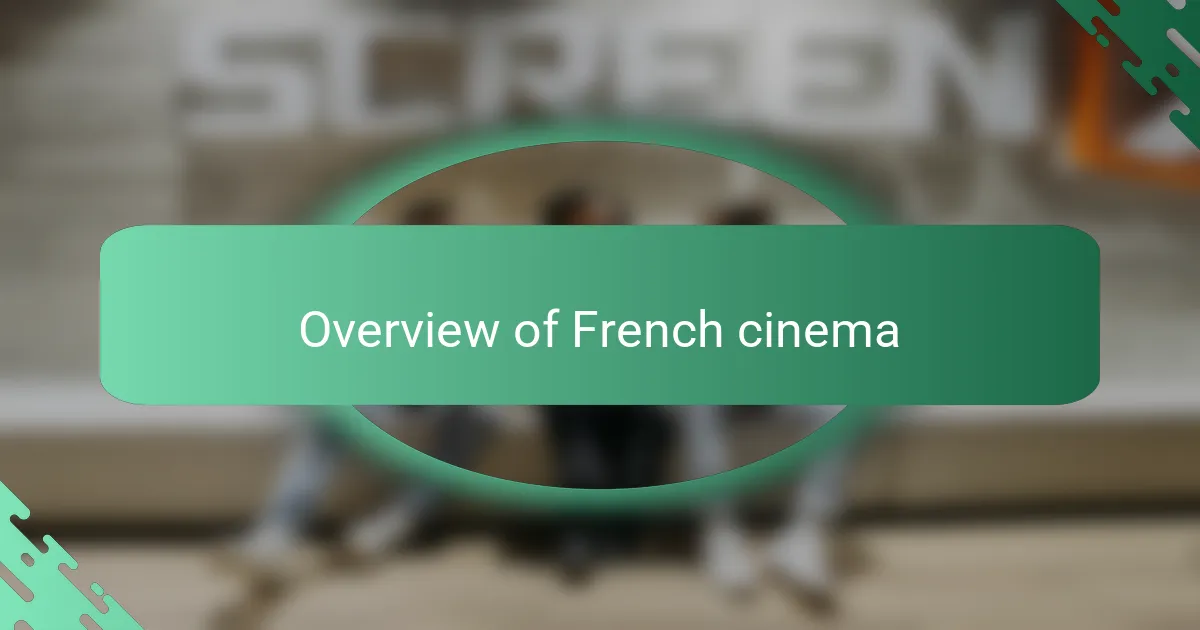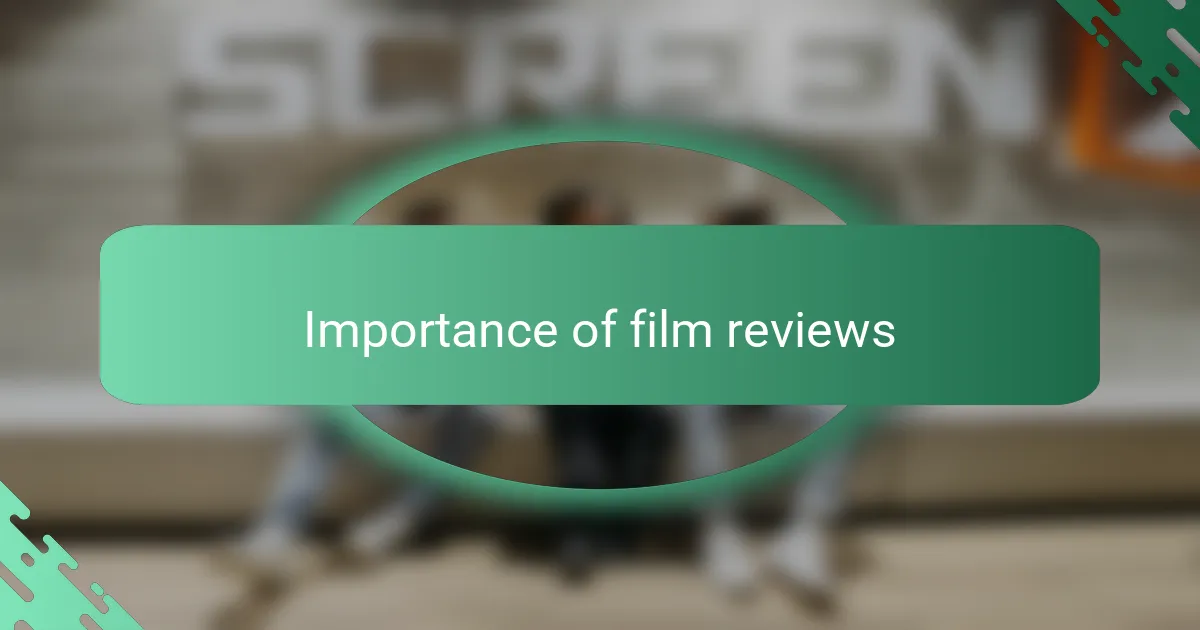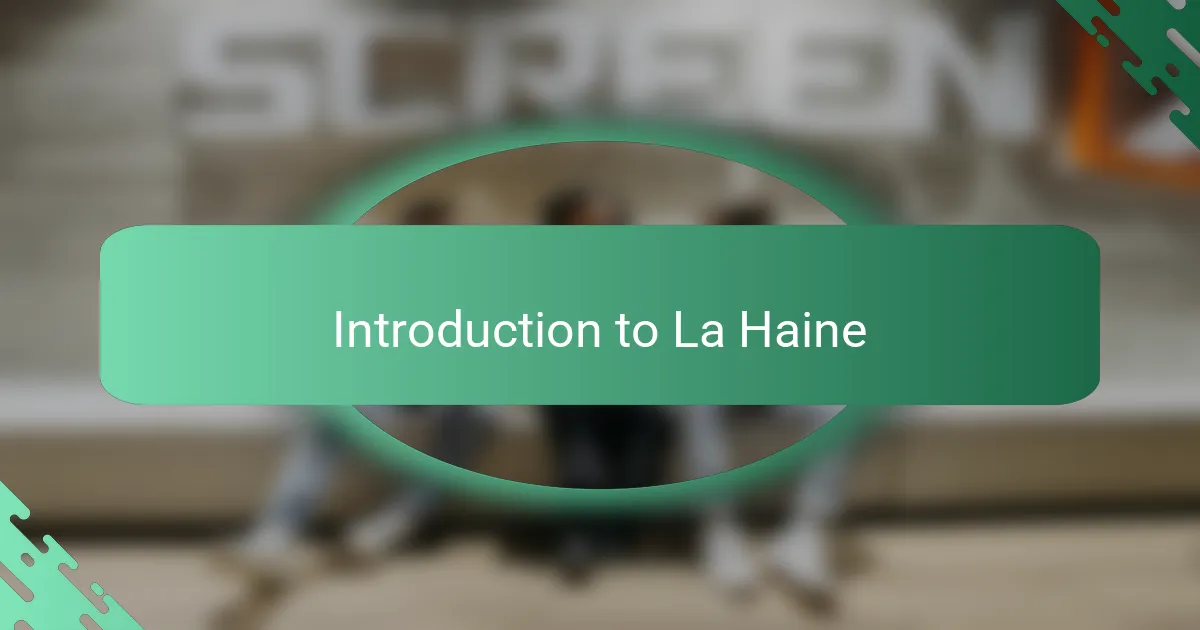Key takeaways
- French cinema is characterized by its artistic approach, complex characters, and exploration of social issues, often blending genres.
- “La Haine” offers a powerful commentary on social unrest, highlighting the cycle of violence and the struggle for identity in marginalized communities.
- Character dynamics in “La Haine” showcase distinct perspectives: Vinz’s anger, Saïd’s humor, and Hubert’s hope, each reflecting real societal challenges.
- Film reviews enhance understanding by providing different interpretations and deepening appreciation of themes like social inequality and despair.

Overview of French cinema
French cinema has a rich tapestry that weaves together diverse narratives, innovative storytelling, and a commitment to exploring complex social themes. I remember the first time I watched a French film; it was like stepping into a world that felt both familiar and strikingly different. Many films delve into the fabric of society, reflecting the nuances of culture, identity, and the human condition.
Here are some defining characteristics of French cinema:
- Artistic approach: Filmmakers often prioritize visual storytelling and aesthetics.
- Emphasis on character development: Characters are complex and multidimensional, often embodying moral ambiguities.
- Exploration of social issues: Films frequently tackle topics such as class struggle, race, and alienation.
- Influence of directors: Iconic directors like Jean-Luc Godard and François Truffaut have shaped the landscape of film with their unique styles.
- Hybrid genres: French cinema often blends genres, creating a distinctive mix of comedy, drama, and thriller elements.
The depth and creativity found in French cinema truly resonate with me, as they remain ever-present in my own appreciation for storytelling.

Importance of film reviews
Film reviews play a crucial role in shaping our understanding and appreciation of movies. Personally, I find that they offer a deeper lens through which to analyze the themes and nuances of a film like “La Haine.” When I first watched it, I felt a rush of emotions, but reading reviews later helped me comprehend the societal issues it addresses, enhancing my overall experience.
Engaging with different perspectives through reviews often brings fresh insights. For instance, some critics highlight the film’s powerful commentary on social unrest, while others focus on its artistic direction. These varying interpretations have enriched my view, making me appreciate the film’s complexity all the more.
Ultimately, film reviews serve as a bridge between the viewer and the filmmaker, allowing us to explore meanings that we might initially overlook. It’s like a conversation, where each review adds a layer to our understanding of the film’s impact on society.
| Aspect | Viewer’s Experience |
|---|---|
| Initial Reaction | Emotional and visceral |
| Role of Reviews | Provides clarity and insights |
| Understanding Themes | Deepens with critical analysis |

Introduction to La Haine
La Haine, directed by Mathieu Kassovitz, is a film that profoundly impacted my understanding of social issues in France. Set in the aftermath of a riot, it follows the lives of three young men grappling with their circumstances. The raw emotions and stark realities portrayed in the film felt like a mirror reflecting the struggles faced in many urban environments, striking a chord with anyone who has experienced feelings of frustration or helplessness.
From its gripping narrative to its striking black-and-white cinematography, La Haine captivates viewers with its intensity. The film’s powerful messages about anger, violence, and friendship continue to resonate, making it a timeless classic in French cinema.
- Captures the socio-political tensions of the 1990s in France.
- Follows three main characters: Vinz, Saïd, and Hubert, each representing different perspectives on their environment.
- Uses a striking black-and-white visual style to emphasize the film’s themes.
- Offers a haunting exploration of despair and the cyclical nature of violence.
- Reminds viewers to consider the human stories behind statistics and headlines.

Key themes in La Haine
One of the most striking themes in “La Haine” is the cycle of violence and its repercussions on individuals and society. Watching the film for the first time left me feeling a mix of anger and sadness. It made me reflect on the characters’ struggles and how their lives are so deeply affected by systemic issues. The raw portrayal of these emotions is both haunting and thought-provoking.
Another significant theme is the concept of identity, particularly within marginalized communities. The film highlights how characters grapple with their sense of self in a world that often defines them by their socio-economic background. This resonates with me on a personal level because I’ve observed similar dynamics in my own community, where individuals battle the stereotypes imposed upon them yet strive to assert their identities in meaningful ways.
Key Themes in “La Haine”:
– The cycle of violence and its devastating effects
– The struggle for identity amidst societal oppression
– The tension between hope and despair in marginalized communities
– Friendship and loyalty in the face of adversity
– Critique of social inequality and police brutality

Character analysis in La Haine
Vinz, Saïd, and Hubert embody distinct yet intertwined perspectives that drive the narrative of “La Haine.” Vinz, fueled by anger and the desire for validation, often acts impulsively, reflecting how frustration can easily transform into violence. I remember feeling a deep sense of empathy for him, recognizing that his rage was a response to the systemic failures around him. Do you ever wonder how many young people feel the same way, caught in a cycle of anger with nowhere to direct it?
Saïd serves as the comic relief but also highlights the absurdity and cruelty of their situation. His light-hearted demeanor juxtaposes the film’s gravity, reminding us that humor can be a coping mechanism in dire circumstances. Watching him navigate through chaos with a smile made me reflect on the power of laughter in even the darkest times. Isn’t it fascinating how some individuals can find moments of joy in the face of despair?
Hubert, on the other hand, represents the voice of reason and the struggle for hope amidst chaos. He grapples with the weight of his friends’ decisions, embodying a poignant internal conflict. I often found myself relating to his desire to rise above the violence while being tied to the very environment he’s trying to escape. It’s a sobering reminder of how difficult it can be to break free from one’s circumstances, and I can’t help but think about the real-life implications this has for many facing similar challenges today.

Personal insights on La Haine
Reflecting on my experience with “La Haine,” I was struck by its raw portrayal of frustration and social unrest. Watching the film, I felt a deep connection to the characters, serving as a stark reminder of the complexities surrounding marginalized communities. The film’s black-and-white aesthetic not only heightened its emotional weight but also underscored the bleakness of their circumstances, making each scene impactful.
One of the most memorable moments for me was the dialogue among the three main characters. Their camaraderie, mixed with humor and despair, resonated with my own experiences in difficult social environments. It felt as though I was witnessing a slice of reality that many outside their world often overlook.
Here’s a quick comparison summarizing the film’s significant elements:
| Aspect | La Haine |
|---|---|
| Theme | Social unrest and alienation |
| Style | Black and white cinematography |
| Main Characters | Vinz, Saïd, Hubert |
| Setting | Banlieues of Paris |
| Emotional Tone | Tense, raw, and reflective |
